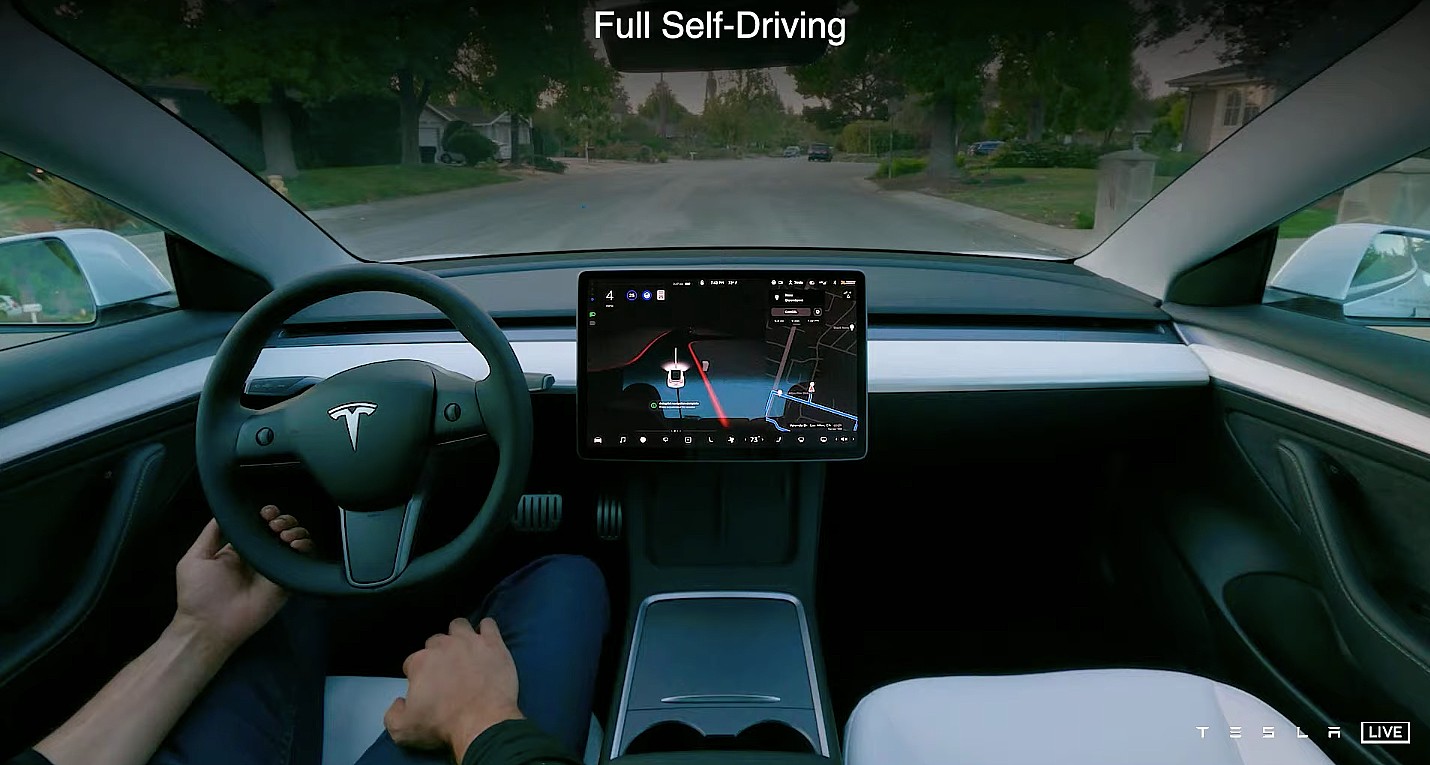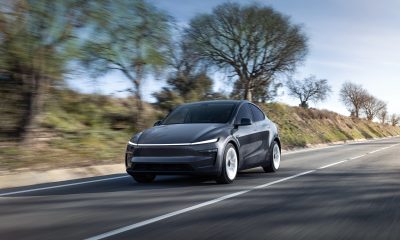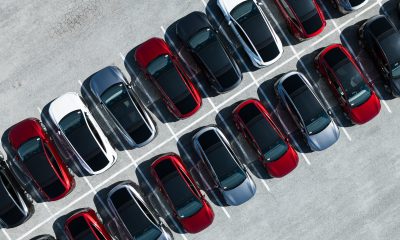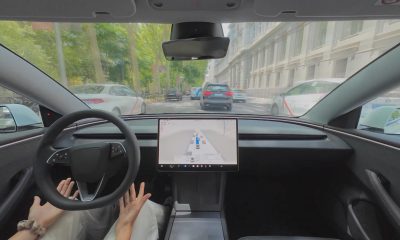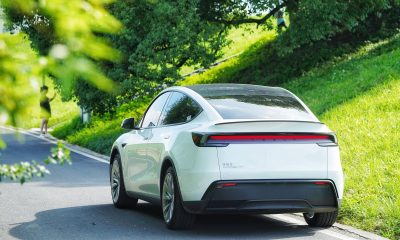Tesla has filed a new patent for “Parallel Processing System Runtime State Reload,” comprising of a system of three or more processors working in conjunction to effectively eliminate the possibility of hardware failure during the use of Autopilot or Full Self-Driving. The patent outlines a robust system of parallel processors that can operate in the event that one of them fails or experiences a runtime state error. “Should one of the parallel processors fail, at least one other processor would be available to continue performing autonomous driving functions,” the patent shows.
The patent was filed and published on August 26th and comes just a week after the company’s Artificial Intelligence Day event that was held last Thursday. Outlining a system of at least three processors operating in parallel, it is monitored by circuitry and can locate and identify if one of the three parallel-operating processors is having a runtime state error. The circuitry will then identify a second processor to switch to in the event of a runtime error, access the runtime state of the second processor, and load the runtime state of the second, operational processor into the first processor, which is experiencing a runtime error.
(Credit: Tesla)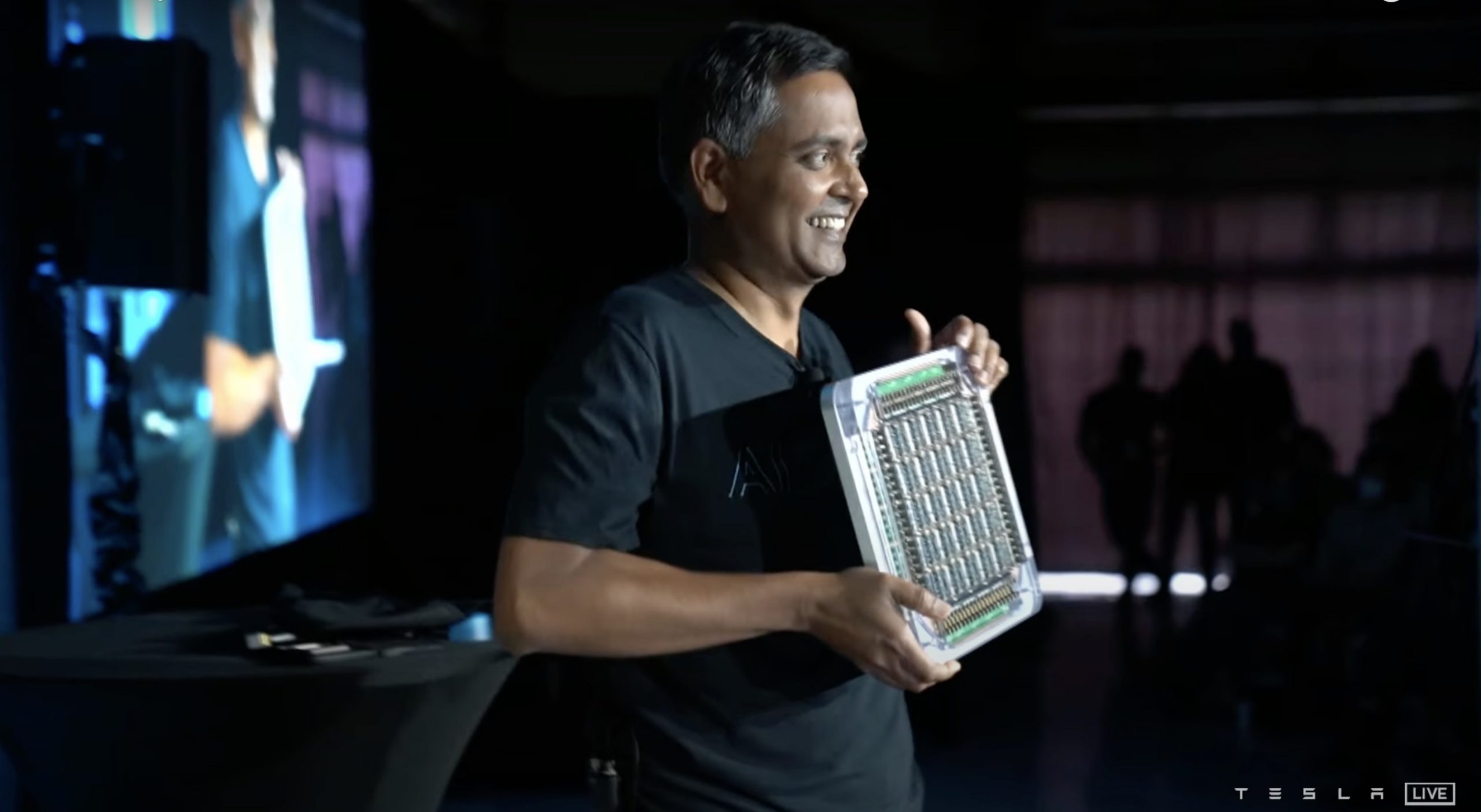
Tesla describes the patent in detail:
“A system on a Chip (SoC) includes a plurality of processing systems arranged on a single integrated circuit. Each of these separate processing systems typically performs a corresponding set of processing functions. The separate processing systems typically interconnect via one or more communication bus structures that include an N-bit wide data bus (N, an integer greater than one). Some SoCs are deployed within systems that require high availability, e.g., financial processing systems, autonomous driving systems, medical processing systems, and air traffic control systems, among others. These parallel processing systems typically operate upon the same input data and include substantially identical processing components, e.g., pipeline structure, so that each of the parallel processing systems, when correctly operating, produces substantially the same output. Thus, should one of the parallel processors fail, at least one other processor would be available to continue performing autonomous driving functions.”
Technically speaking, the autonomous vehicle needs only one processor to function as described in an accurate fashion. However, these processors can be overloaded with data when loading into the Neural Network and could experience short-term and non-permanent operational errors. When this occurs, the system would then switch to one of the other processors for normal operation, with at least two backup processors in this patent, as it repeatedly mentions a series of three.
Tesla details its self-driving Supercomputer that will bring in the Dojo era
The second processor would then activate and load the runtime state into the first processor to make the primary processor chip operational once again:
“Thus, in order to overcome the above-described shortcomings, among other shortcomings, a parallel processing system of an embodiment of the present disclosure includes at least three processors operating in parallel, state monitoring circuitry, and state reload circuitry. The state monitoring circuitry couples to the at least three parallel processors and is configured to monitor runtime states of the at least three parallel processors and identify a first processor of the at least three parallel processors having at least one runtime state error. The state reload circuitry couples to the at least three parallel processors and is configured to select a second processor of the at least three parallel processors for state reload, access a runtime state of the second processor, and load the runtime state of the second processor into the first processor.”
The purpose of this patent is to continue system availability, even when the primary processor is experiencing functionality issues due to overuse. The two additional processors essentially act as “backup” and can determine whether autonomous driving systems are meant to be enabled if the first processor experiences an error. “With one particular example of this aspect, the parallel processing system supports autonomous driving and the respective sub-systems of the at least three parallel processors are safety sub-systems that determine whether autonomous driving is to be enabled.”
FIG. 13 is a timing diagram illustrating clocks of the circuits of FIGS. 8 and 10 according to one or more other described embodiments. As shown, the runtime state (data1) of first processor/first sub-system is determined to have at least one error. In response to this determination by the state monitoring/state reload circuitry, the signal st_reload1 is asserted to initiate the loading of runtime state (data2) from second processor/second sub-system into the first processor/first sub-system. With the embodiment of FIG. 13, a first clock (clk1) is used for the first processor/first sub-system and a second clock (clk1) is used for the second processor/second sub-system. There exists a positive skew between the first clock (clk1) and the second clock (clk2), resulting in a late cycle of the loading of the runtime state (data2) of the second processor/second sub-system into the first processor/sub-system, potentially resulting in errors in the runtime state reload process. (Credit: U.S. Patent Office)
It also appears that this patent aligns with Tesla CEO Elon Musk’s previous description of the Dojo self-driving Supercomputer, which was detailed at AI Day. To increase the accuracy and encourage the parallel operation of the processors, the system will utilize a clock input to calibrate the two processors, increasing the accuracy of the system.
Tesla has focused on accurate FSD operation and has revised its strategy on several occasions. After moving to a camera-only approach earlier this year for the Model 3 and Model Y, the company is experiencing more accurate FSD operation through the harmonized processing of its eight exterior cameras. The operation of internal processors, which are responsible for compiling, compressing, and sending data to the Neural Network, can fail temporarily, so the presence of backup processors to continue comprehending self-driving data is a positive idea.
The full patent is available below:
Tesla Patent Parallel Processing System Runtime State Reload by Joey Klender on Scribd
News
Tesla UK sales see 14% year-over-year rebound in June: SMMT data
The SMMT stated that Tesla sales grew 14% year-over-year to 7,719 units in June 2025.

Tesla’s sales in the United Kingdom rose in June, climbing 14% year-over-year to 7,719 units, as per data from the Society of Motor Manufacturers and Traders (SMMT). The spike in the company’s sales coincided with the first deliveries of the updated Model Y last month.
Model Y deliveries support Tesla’s UK recovery
Tesla’s June performance marked one of its strongest months in the UK so far this year, with new Model Y deliveries contributing significantly to the company’s momentum.
While the SMMT listed Tesla with 7,719 deliveries in June, independent data from New AutoMotive suggested that the electric vehicle maker registered 7,891 units during the month instead. However, year-to-date figures for Tesla remain 2% down compared to 2024, as per a report from Reuters.
While Tesla made a strong showing in June, rivals are also growing. Chinese automaker BYD saw UK sales rise nearly fourfold to 2,498 units, while Ford posted the highest EV growth among major automakers, with a more than fourfold increase in the first half of 2025.
Overall, the UK’s battery electric vehicle (BEV) demand surged 39% to to 47,354 units last month, helping push total new car sales in the UK to 191,316 units, up 6.7% from the same period in 2024.
EV adoption accelerates, but concerns linger
June marked the best month for UK car sales since 2019, though the SMMT cautioned that growth in the electric vehicle sector remains heavily dependent on discounting and support programs. Still, one in four new vehicle buyers in June chose a battery electric vehicle.
SMMT Chief Executive Mike Hawes noted that despite strong BEV demand, sales levels are still below regulatory targets. “Further growth in sales, and the sector will rely on increased and improved charging facilities to boost mainstream electric vehicle adoption,” Hawes stated.
Also taking effect this week was a new US-UK trade deal, which lowers tariffs on UK car exports to the United States from 27.5% to 10%. The agreement could benefit UK-based EV producers aiming to expand across the country.
News
Tesla Model 3 ranks as the safest new car in Europe for 2025, per Euro NCAP tests
Despite being on the market longer than many of its rivals, the Tesla Model 3 continues to set the bar for vehicle safety.
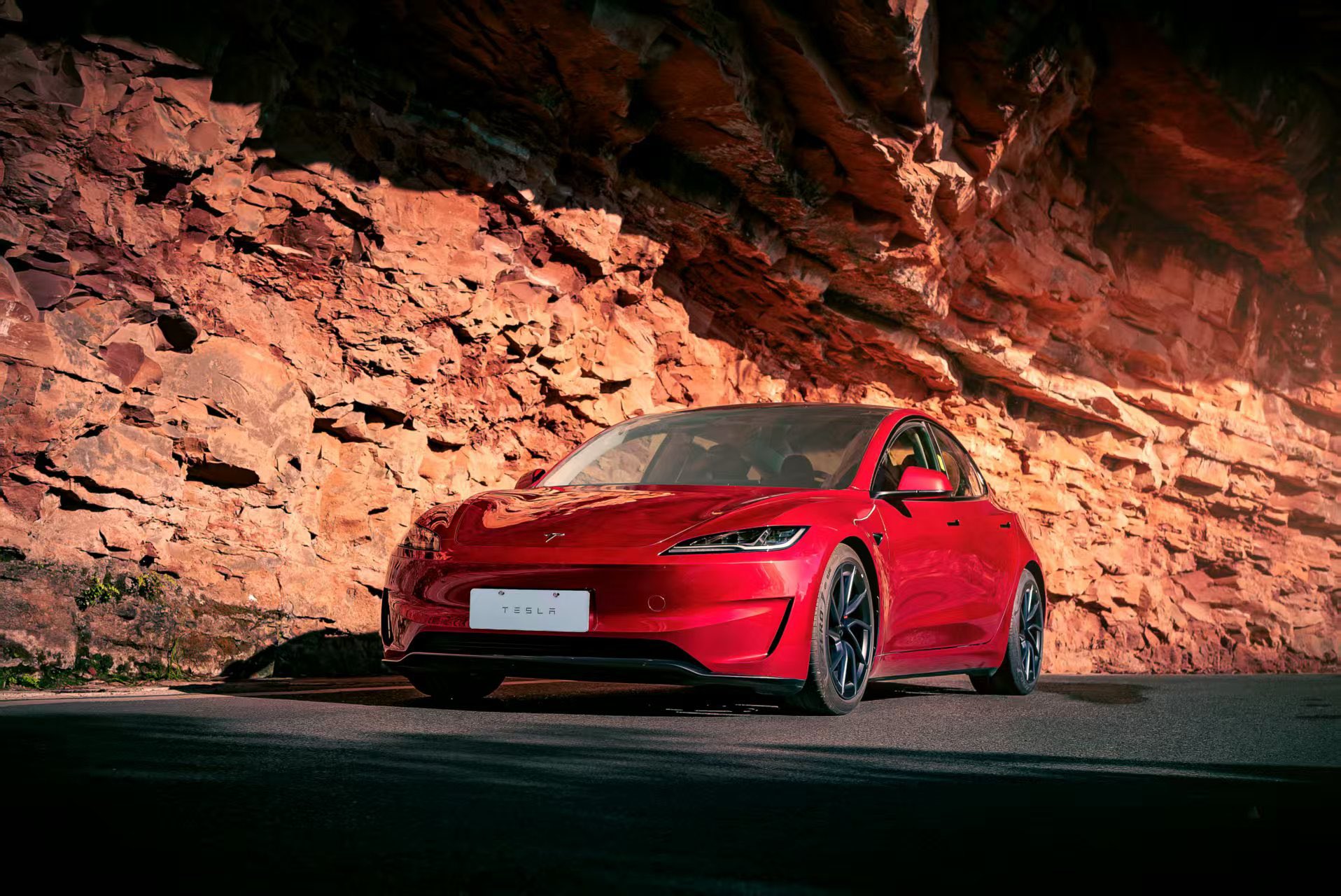
The Tesla Model 3 has been named the safest new car on sale in 2025, according to the latest results from the Euro NCAP. Among 20 newly tested vehicles, the Model 3 emerged at the top of the list, scoring an impressive 359 out of 400 possible points across all major safety categories.
Tesla Model 3’s safety systems
Despite being on the market longer than many of its rivals, the Tesla Model 3 continues to set the bar for vehicle safety. Under Euro NCAP’s stricter 2025 testing protocols, the electric sedan earned 90% for adult occupant protection, 93% for child occupant protection, 89% for pedestrian protection, and 87% for its Safety Assist systems.
The updated Model 3 received particular praise for its advanced driver assistance features, including Tesla’s autonomous emergency braking (AEB) system, which performed well across various test scenarios. Its Intelligent Speed Assistance and child presence detection system were cited as noteworthy features as well, as per a WhatCar report.
Other notable safety features include the Model 3’s pedestrian-friendly pop-up hood and robust crash protection for both front and side collisions. Euro NCAP also highlighted the Model 3’s ability to detect vulnerable road users during complex maneuvers, such as turning across oncoming traffic.
Euro NCAP’s Autopilot caution
While the Model 3’s safety scores were impressive across the board, Euro NCAP did raise concerns about driver expectations of Tesla’s Autopilot system. The organization warned that some owners may overestimate the system’s capabilities, potentially leading to misuse or inattention behind the wheel. Even so, the Model 3 remained the highest-scoring vehicle tested under Euro NCAP’s updated criteria this year.
The Euro NCAP’s concerns are also quite interesting because Tesla’s Full Self-Driving (FSD) Supervised, which is arguably the company’s most robust safety suite, is not allowed for public rollout in Europe yet. FSD Supervised would allow the Model 3 to navigate inner city streets with only minimal human supervision.
Other top scorers included the Volkswagen ID.7, Polestar 3, and Geely EX5, but none matched the Model 3’s total score or consistency across categories. A total of 14 out of 20 newly tested cars earned five stars, while several models, including the Kia EV3, MG ZS, and Renault 5, fell short of the top rating.
Elon Musk
Why Tesla’s Q3 could be one of its biggest quarters in history
Tesla could stand to benefit from the removal of the $7,500 EV tax credit at the end of Q3.

Tesla has gotten off to a slow start in 2025, as the first half of the year has not been one to remember from a delivery perspective.
However, Q3 could end up being one of the best the company has had in history, with the United States potentially being a major contributor to what might reverse a slow start to the year.
Earlier today, the United States’ House of Representatives officially passed President Trump’s “Big Beautiful Bill,” after it made its way through the Senate earlier this week. The bill will head to President Trump, as he looks to sign it before his July 4 deadline.
The Bill will effectively bring closure to the $7,500 EV tax credit, which will end on September 30, 2025. This means, over the next three months in the United States, those who are looking to buy an EV will have their last chance to take advantage of the credit. EVs will then be, for most people, $7,500 more expensive, in essence.
The tax credit is available to any single filer who makes under $150,000 per year, $225,000 a year to a head of household, and $300,000 to couples filing jointly.
Ending the tax credit was expected with the Trump administration, as his policies have leaned significantly toward reliance on fossil fuels, ending what he calls an “EV mandate.” He has used this phrase several times in disagreements with Tesla CEO Elon Musk.
Nevertheless, those who have been on the fence about buying a Tesla, or any EV, for that matter, will have some decisions to make in the next three months. While all companies will stand to benefit from this time crunch, Tesla could be the true winner because of its sheer volume.
If things are done correctly, meaning if Tesla can also offer incentives like 0% APR, special pricing on leasing or financing, or other advantages (like free Red, White, and Blue for a short period of time in celebration of Independence Day), it could see some real volume in sales this quarter.
You can now buy a Tesla in Red, White, and Blue for free until July 14 https://t.co/iAwhaRFOH0
— TESLARATI (@Teslarati) July 3, 2025
Tesla is just a shade under 721,000 deliveries for the year, so it’s on pace for roughly 1.4 million for 2025. This would be a decrease from the 1.8 million cars it delivered in each of the last two years. Traditionally, the second half of the year has produced Tesla’s strongest quarters. Its top three quarters in terms of deliveries are Q4 2024 with 495,570 vehicles, Q4 2023 with 484,507 vehicles, and Q3 2024 with 462,890 vehicles.
-

 Elon Musk4 days ago
Elon Musk4 days agoTesla investors will be shocked by Jim Cramer’s latest assessment
-

 News1 week ago
News1 week agoTesla Robotaxi’s biggest challenge seems to be this one thing
-

 Elon Musk2 weeks ago
Elon Musk2 weeks agoFirst Look at Tesla’s Robotaxi App: features, design, and more
-

 News2 weeks ago
News2 weeks agoSpaceX and Elon Musk share insights on Starship Ship 36’s RUD
-

 News2 weeks ago
News2 weeks agoWatch Tesla’s first driverless public Robotaxi rides in Texas
-
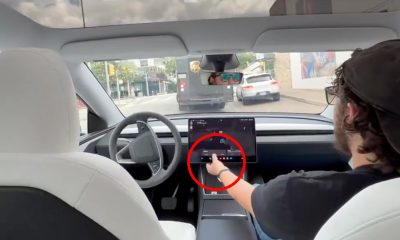
 News1 week ago
News1 week agoWatch the first true Tesla Robotaxi intervention by safety monitor
-

 News2 weeks ago
News2 weeks agoTesla has started rolling out initial round of Robotaxi invites
-

 Elon Musk2 weeks ago
Elon Musk2 weeks agoTesla to launch in India in July with vehicles already arriving: report

